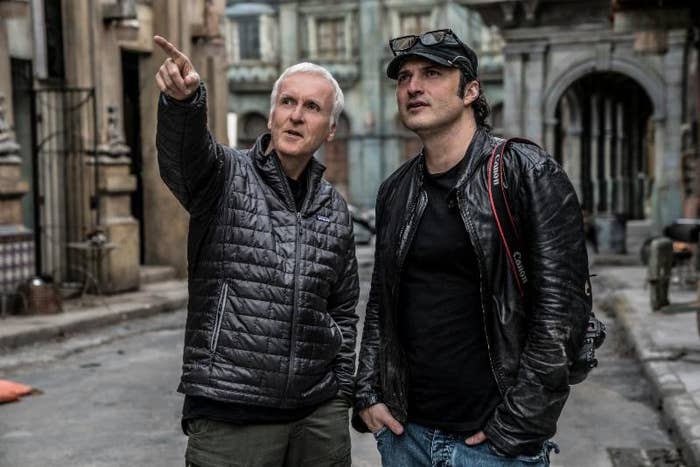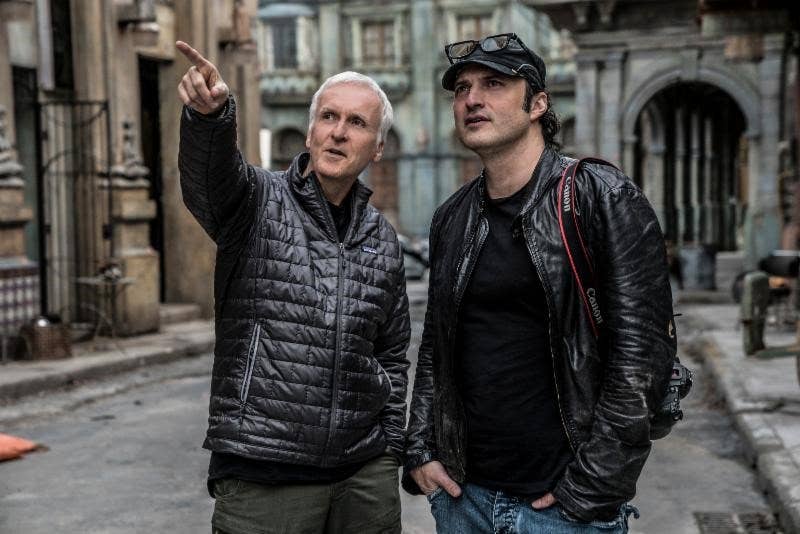
When the first trailer for Alita: Battle Angel hit the internet in December of 2017, one thing immediately jumped out: Those eyes. Those very big eyes. Alita, the titular protagonist—played by real-life human Rosa Salazar—in Robert Rodriguez’s new dystopian sci-fi saga, is a teenage cyborg warrior with peepers so large, they’d make Bambi blush. The reaction online was mixed. Some people thought they were creepy, while others were relieved that Rodriguez was staying true to the character’s manga roots.
But as Rodriguez told Complex, it wasn’t his decision to imbue the film’s heroine with iconic anime-style eyes. That was all James Cameron, who’d been developing the film based on Yukito Kishiro’s beloved cyberpunk manga Battle Angel Alita for nearly two decades before Rodriguez signed on to direct. In fact, Cameron’s fingerprints are all over the finished product, from the technological wizardry and expansive world-building to the story’s deep emotional core. But make no mistake: Even with Cameron’s heavy involvement in all aspects of the production, this is very much a Robert Rodriguez film.
The cowboy hat-wearing Texan burst onto the scene in 1992, when his student film El Mariachi—which became a part of Hollywood folklore thanks to its reported shoestring $7000 budget—took home the top prize at Sundance. Since then, Rodriguez has been making some of the most gloriously stylized and cartoonishly violent genre movies ever. What’s even more impressive, is that he made films like Desperado, Sin City and From Dusk Till Dawn, all from the remote confines of his Austin studio, far removed from the big bad Hollywood machine. And while the $200 million Alita: Battle Angel might be his most Hollywood movie to date, it’s brimming with the same kinetic energy and ingenuity that’s helped make Rodriguez one of our most exciting auteurs.
Here, the director discusses working with James Cameron, adapting a manga for American audiences, and of course, those eyes.
When adapting a manga text for Hollywood, issues of representation are important. For instance, Ghost in The Shell came under fire for alleged whitewashing. How much did that affect the casting process? Was it important to you to have as diverse a cast as possible?
What was cool is that that’s what Jim latched onto when he first got the rights in 1999, is that it wasn’t something as Asian-specific as Ghost in The Shell or Akira, which are set in neo Tokyo. This is something that’s much more of a melting pot, it’s not set somewhere specifically Asian. It’s a cyborg girl in the lead, and even in the manga it’s set in one of the last standing cities left, so by nature there’s multiple languages being spoken, with people from all over the world could coming there, so it was always sort of a melting pot. The original story was set in Kansas City, but Jim early on figured out that it should be set near an equator because that’s where scientifically a space elevator would work. I thought that was fantastic, so let’s do Panama City, which is a Latin country, and we’ve never seen that in a sci-fi film before. And with all the different cultures, it’s just naturally diverse, so the diversity was actually part of the original script.
There was a very strong reaction to Alita’s large anime eyes when you released the initial trailer. Was that a decision you made in the early stages?
We knew we were going to do it right from the start, before even I came on board. When I saw Jim’s artwork for the movie that he was putting together in 2005, it had the most arresting image of a porcelain-armed doll face with large eyes right out of the manga, but a photorealistic painting. And i thought, ‘Wow. He was going to try this in 2005!” He’s always pushing the envelope and he’s always giving you something you’ve never seen before, so I realized that was the hook that he was going to do, just like Avatar with the Na’vi. This was going to be what makes it different. So I knew I had to do that and make her look so real that people would buy into it. So we had to put a trailer out before we even really started on her because originally the movie was set to be released last summer, and she wasn’t at all ready to be seen. So when people commented on the eyes, it wasn’t finished yet. In fact, Jim’s comment was that they weren’t big enough. He actually said, “You’re always going to get the big eye comment—and I went through this on Avatar—until you make the irises bigger.” I said, “Really?” He goes, “Yeah, 30 percent bigger. You could get away with 18 or 20, but I would go 30.” So we tried it and sure enough he was right. People think that we shrunk her eyes but if you put them side by side, you see that they’re the same size, but the irises are bigger, and that’s what gives it the illusion. That’s the genius of Jim Cameron. No one else could see that but him.
What do you think are the biggest differences between anime and manga source texts and American comic books, and how did you try and make something that’s so foreign more palatable to American audiences?
It all comes down to story and script, and Jim’s the best at that. I read the script before I read the original story and I was like, “Oh wow, he really took inspiration from the manga but he crafted a more cinematic story like his other movies.” They can play to all audiences all around the world. He said that early on with me, that we should make this a broad appeal movie because with the budget that we have and the technology that we’re trying to create, if we just appeal to the manga fans, we’re not going to have a big enough release. So we definitely tempered it with a cinematic story. But with that said, it’s still episodic like a manga, it’s totally inspired by all the things in a manga that we love, and it’s exciting because it is so different from our sensibilities. But we tempered it somewhat, which I also did with Sin City. It was so violent, I remember thinking people would be running and screaming out the door, so I had to balance that out. Even the manga version of Alita is very graphic and gory.
Are you worried that American audiences might have a hard time connecting to material like this after the box office failure of Ghost in The Shell?
The material is totally different. That material, if you think about it, is a lot colder, very tech savvy and didn’t have the warm story that the original Alita has. I think people will be so surprised by how accessible, emotional and relatable it is. Even Kishiro was shocked that it had that much heart in it. That’s Jim. It’s got to connect to people who don’t know what a manga is, who don’t care about science fiction. They have to walk away thinking this movie is for them. Jim’s stories have themes that are bigger than the genre that they’re in. That’s what he does.
Yeah, I remember seeing Avatar and despite the concept being very high-pitched, I left feeling emotionally impacted.
Yeah, he knows what he wants to accomplish with the movie from a technological viewpoint, but he also knows that to pay for that he's going to have to give people an emotional experience. So he concentrates on the emotional story. In Titanic, before you even saw an iceberg, it was all about the characters, and he knows that’s what’s going to connect with audiences. What makes a great Jim Cameron movie is the balance between truth and spectacle. The spectacle is why you go to a movie like Avatar and Alita, but it’s the human truth that connects with people. That’s what they take home with them.
You make films for Hollywood audiences but you’re far removed from the machinery of it all. How does working and living in Austin affect your sensibilities as a filmmaker?
It’s been so great being over here. George Lucas once said to me, “Man, it’s so smart that you’re in Austin. That’s why I’m in Marin County. Stay out of Hollywood because when you’re in the box that everyone else is in. you don’t think beyond the tradition. When you live outside of the box like you’re doing, you’re automatically going to think outside the box. You’re just going to trip over innovation.” And sure enough, within a couple years I was doing digital photography before anybody, or all green screen movies, or the first digital 3D movie with Jim’s cameras that he designed for his underwater adventure. I was just finding all kinds of innovations because no one is around you to tell you “No, that’s not how we do things,” so you just come up with methodology and that’s why Jim wanted me to shoot Alita here, because he always liked that I was innovating. You’re not following what everyone else is doing at all. You’re off far in the deep end just coming up with new ideas.
I know you’re close with Quentin Tarantino so I have to ask. Has he shown you a rough cut of Once Upon a Time in Hollywood yet?
I can’t say! But his movies are so fun to watch in their rough cut stages and I always look forward to that because his movies play just like the finished version. It’s unbelievable. I’ve never seen anyone work like that. He doesn’t use any digital effects. He just shoots reel for reel, so he’s got it cut together pretty quickly, so you can just watch it and enjoy it.
Your films are very much meant to be experienced on the big screen, but do you ever see yourself making something specifically for a streaming platform somewhere down the line?
I think there’s some stories you can tell where they could take more chances with something. With theatrical and all the marketing costs of putting something out, or if you want to target a very specific audience they don’t really do that on a studio level anymore. But the streaming services do because they have to satisfy all their customers, so I can definitely see myself doing something like that. But we shot this movie in Real 3D and the effects are off the charts, so it has to be seen on the biggest screen possible.

